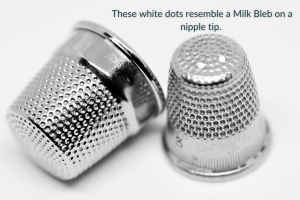Ouch!!! Blocked ducts can be a real pain.
What’s worse, some women tend to suffer repeatedly from blocked ducts, especially those that have a plentiful supply.
What are Blocked Ducts?
Blocked ducts are an accumulation of milk or dead cells that clog up a milk duct, so that the milk cannot move freely through the ducts and out the nipple, just like a blocked pipe.
Blocked ducts present as hard tender lumps, often described as pea-sized initially. They appear most often on the upper outer quadrant of either breast. Sometimes a tiny white dot can be seen on the nipple. This is called a milk bleb and when it is freed, it can look like a white string being pulled out of the nipple.

So, you’ve noticed a lump on your breast that is tender to the touch, or you have a red spot on your breast, or a white dot on your nipple. Is your baby fussing more on one side suddenly? Are you noticing that one breast isn’t draining and baby is still hungry? Has one of your older kids accidentally head-butted your breast and now you are swollen and sore and blocked? (yes this happens!)
Causes of blocked ducts:
The main cause of blocked ducts is insufficient drainage. Breastfeeding is predicated on a system of supply and demand. Your breasts make milk based on prior demand. If there is a change in pattern or reduction in demand, milk stasis can occur, and blocked ducts can result. Here are some of the main causes:
- Incomplete drainage due to a missed feed, or ill-fitting bra, teething, pacifier use, being a busy mom, hurried weaning from breastfeeding.
- Stress can lead to delayed let down and a reduction in milk produced,
- Poor latch may cause insufficient milk removal. You should feel a noticeable softness in your breast after a feed.
- Breast massage that is too vigorous (those ducts are near the surface and are easily collapsible).
- Ill-fitting nipple shields.
- Infection – a sore or cracked nipple can be a gateway for bacteria or yeast to get in to the breast tissue, which could lead to mastitis or an abscess.
Interestingly, the incidence of blocked ducts increases in the winter. It is thought that this is because we wear more constrictive clothing in the winter!
Treating Blocked Ducts

But what can you do? LOTS:
- Start every breastfeeding session from the blocked side. Baby is the most efficient sucker there is. Ensure this breast is never engorged, but drained regularly, even if you have to hand express/pump.
- Hop into a hot shower or bath (preferable) and let the hot water flow over your breast and also massage your breast over the affected area.
- Get a baby’s nappy, soak it in hot water (not boiling but as hot as you can handle), and wrap it around your breast. You do this in order to initiate a let-down. However, if you blocked duct isn’t clearing then applying heat too often can just inflame the inflammation!!
- While baby is feeding, gently massage the area. Those ducts are close to the surface and are easily collapsible if you press too firmly so massage gently, and towards your nipple.
- Point your baby’s chin in the direction of the blockage (yes this may mean her legs are over your shoulder).
- Gently compress your breast while baby sucks, and massage the breast towards the nipple. Stop when she stops.
- If you have a personal massager, or electric toothbrush, use this over the area to help dislodge the blockage.
- If you have a silicone breast pump, dissolve some Epsom salts in hot water and let it cool to a warm temperature. Place it over your nipple and squeeze it so the mixture is in constant contact with your nipples for 5-10 mins. The sulphates in Epsom salt help draw out toxins, which is a process called reverse osmosis.
- Get down on all fours and feed your baby. Gravity can really help, and many mums find this to be the tip that works.
- Apply a cold compress after feeding to help reduce inflammation.
- Carol Smyth wrote an excellent article on engorgement, blocked ducts and mastitis and suggests a new treatment that you can do yourself called SSRMT.
- Therapeutic Ultrasound- this therapy is commonly used in Australia for treating blocked ducts and mastitis, and is only starting to be practiced here in Ireland for this purpose. At present it is only offered by Physiotherapists, but there is a developing interest amongst Lactation Consultant’s as the reported effects are so positive. Therapeutic Ultrasound causes two effects: 1- the heat penetrates down into the breast tissue, and 2- the ultrasonic waves cause vibration of the fluid in that area, therefore causing blockages to break up and dissolve much faster. A word of caution: while the anecdotal evidence for this treatment is excellent, there is very scant clinical research to support it.
- If trauma caused your blockage and you feel swollen, consider taking an anti-inflammatory to help the surrounding tissues.

If its been more than 24 hours of trying to clear your blocked duct with no success, and/or you begin to feel unwell with flu-like symptoms and a temperature you should contact your GP for assessment and possible treatment. Don’t delay if you feel unwell.
Some blocked ducts resolve quickly, while others don’t. If you are suffering from recurrent blocked ducts, make sure to contact your local Lactation Consultant, who can help you figure out why, and make the necessary changes, thus ensuring that your blocked ducts are a thing of the past.

